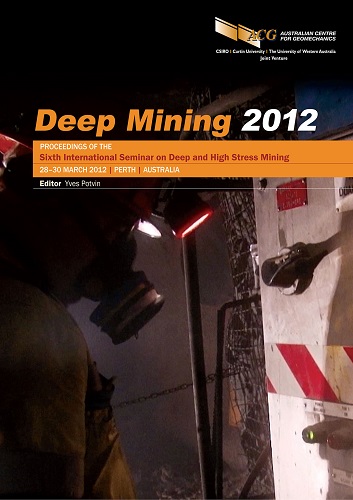Refrigeration and cooling system design ‒ a case study

|
Authors: Marx, W; Bezuidenhout, M; van den Berg, L; Botha, P; Meredith, G |
DOI https://doi.org/10.36487/ACG_rep/1201_34_marx_vandenberg
Cite As:
Marx, W, Bezuidenhout, M, van den Berg, L, Botha, P & Meredith, G 2012, 'Refrigeration and cooling system design ‒ a case study', in Y Potvin (ed.), Deep Mining 2012: Proceedings of the Sixth International Seminar on Deep and High Stress Mining, Australian Centre for Geomechanics, Perth, pp. 463-471, https://doi.org/10.36487/ACG_rep/1201_34_marx_vandenberg
Abstract:
Rio Tinto’s Palabora Mining Company (PMC) mines copper from its underground block cave operation in Limpopo, South Africa. The block-cave is situated below the discontinued open pit operation at an ultimate depth of 1,200 m below surface. Ore is currently extracted at over 30,000 t per day (11 Mtpa) and will be extended by 10 to 20% in loading crosscuts which will require additional air and cooling for undercut and crosscut development and ultimately mining. In addition to the increase in airflow requirements, underground crusher airflow has to be increased to adequately cater for dust dilution. The increase in airflow is achieved by re-using ventilation air from the crushers and Belt Level, which are ventilated directly to the return airway system. The air being re-used needs to be cleared of dust and cooled to an acceptable temperature. The air cooling required was calculated as 3,000 kWR. Trade-off studies were conducted to determine the optimum refrigeration and cooling design. Options included refrigeration plant positioned on surface or underground, with several variations in the cooling associated system. Underground refrigeration and underground bulk air cooling proved to be the best option using a phase-in approach to match mine development scheduling. Once the refrigeration and cooling requirements were confirmed, an underground air refrigeration plant and cooling spray chamber engineering design was initiated. The spray chamber will remove nuisance dust and heat from the conveyors and crushers before air is re-introduced to the intake system. An underground refrigeration plant will be installed to satisfy the current additional refrigeration demand of 3,500 kWR.
References:
Marx, W.M., Hooman, M., Botha, P. and Meredith, G. (2010) Cooling system design for a block cave mine, in Proceedings Mine Ventilation Society of SA Conference, 13–14 May, Johannesburg, South Africa.
Marx, W.M., Bezuidenhout, M., Botha, P. and Meredith, G. (2009) Refrigeration and cooling design case study: Palabora Mining Company, in Proceedings Ninth International Mine Ventilation Congress, 10–13 November, New Delhi, India.
Von Glehn, F.H., Marx, W.M. and Botha, P. (2007) Estimation of ventilation and cooling requirements for cave mining in hot rock, in Proceedings Southern African Institute of Mining and Metallurgy, 1st International Symposium on Block and Sub-Level Caving, 8–10 October, Cape Town, South Africa.
© Copyright 2025, Australian Centre for Geomechanics (ACG), The University of Western Australia. All rights reserved.
View copyright/legal information
Please direct any queries or error reports to repository-acg@uwa.edu.au
View copyright/legal information
Please direct any queries or error reports to repository-acg@uwa.edu.au